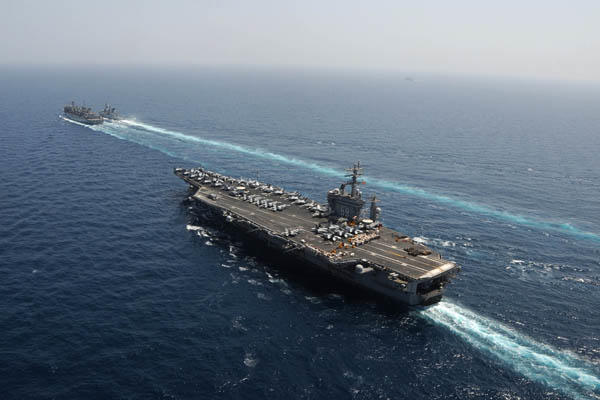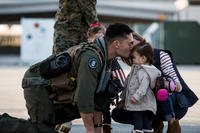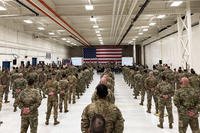"Aircraft carriers and their escorts will shift next year to a radically new deployment plan that offers more scheduling certainty with a trade-off — more time deployed. Under the new regime, a carrier strike group will undergo one work-up cycle and then deploy twice before heading into an overhaul back home. Each cruise lasts seven months."
"The plan would be to get back to being predictable," said Rear Adm. James Foggo, the director of the Navy's Assessment Division, which is based at the Pentagon. "Ideally, we would like to tell the sailors in our fleet that you will deploy on this date, you will return on this date, you will deploy on this date, you will return on this date. So we're trying to get away from that surge response that is unpredictable and is impacting our [personnel tempo] and time back in home port."
-Excerpts from Navy Times cover story—"The New Deployment Plan"
Below is a brief explanation about the potential Enhanced Carrier Presence (ECP) plan, what it would mean for the upkeep of our fleet and most importantly—why you and your family should care. It is important to understand that while this plan has not yet been finalized, it would likely become reality and revolutionize how we train, maintain and deploy.
Three Takeaways:
- ECP would provide "predictability" for Sailors and their families.
Short-notice requests from Combatant Commands (COCOMs), in addition to already-planned deployments, have forced reactive surges and deployment extensions – this unpredictability stresses our people, ships and maintenance force. - With ship service-life in mind, ECP provides a better model for maintenance, which would allow us to complete CVN, SSN and SSBN availabilities on time.
Erratic maintenance schedules and deferral of important maintenance is a result of unscheduled deployments and schedule changes, which negatively impacts the condition of our ships, submarines, aircraft and equipment. - The demand for naval forces has never been greater and will continue to remain high in the future—ECP would allow us to continuously operate forward and meet emergent demands without stressing our force.
Once funded, we anticipate the first Carrier Strike Group (CSG) would begin the ECP cycle in late 2014—we will continue to provide more info as the schedule becomes clearer.
Common Questions and Answers:
Q: What are we doing now for deployments?
A: We are currently using what's called the Fleet Response Training Plan (FRTP) to train and maintain ships and aircraft. The current deployment plan organizes the training and maintenance of ships and aircraft in the CSG to conduct one deployment (nominally seven months) per 32-month cycle; the CSG is thereafter available to deploy for contingencies for up to12 months. In recent years, emergent requests have forced us to surge CSGs, quickly re-deploying CSGs that had just returned from deployments. These surge requests have a trickle-down effect that impacts all carrier schedules.
Q: What is different about ECP? How long will I deploy?
A: It's important to understand ECP is still a plan that hasn't been finalized yet and a lot of the specifics are still pre-decisional. With that in mind, to support ECP, we're looking at extending the current FRTP cycle by four months, creating a 36-month cycle, which would allow us to deploy ships twice for every training iteration. Essentially, the cycle would look like this: six-months of maintenance, six-months training, one-month sustainment (POM), seven-months deployed, seven-months sustainment, seven-months deployed, followed by two-months sustainment.
Q: How would ECP help a CSG and Personnel Tempo (PERSTEMPO)?
A: ECP is designed to deploy CSGs twice within each 36-month operating cycle. ECP would allow us to give Sailors time at home that meets PERSTEMPO and OPTEMPO limits, and would also allow us enough time to properly maintain our ships and aircraft. What's different from the current FRTP, is that ECP trains and maintains the CSG once for two deployments and would prevent us from having to surge CSGs to meet emergent demands. Rather than training the strike group each time before deployment, ECP incorporates training that would keep the CSG proficient throughout two deployments. Essentially, that means the Navy can deliver a set amount of overseas CSG presence and forego the need to surge and stress our force, except in the most extreme of contingencies.
Q: An additional seven-month deployment, does that mean more money is required to fund ECP?
A: ECP is still a plan right now and it is not fully funded. Our FY14 budget includes the near-term investment in personnel, operations and shipyard capacity needed to implement ECP. However, future investments (in CVN and aircraft recapitalization in particular) would need to be addressed because there would be an increased use of our ships and aircraft over time. Ultimately, for a 20 percent increase in investment, we could increase our global presence by 40 percent, while at the same time providing predictability and maintenance stability.
Q: When will ships transition to ECP?
A: The transition to ECP would take two years, starting in approximately late 2014. By implementing scheduling, training and deployments based on reality – we could use ECP to establish a more sustainable process for training and maintaining our rotationally deploying ships, aircraft and crews. Ultimately, ECP would create predictability for our Sailors and their families, as well as leadership and industry.
Ok, now it's your turn — tell the Navy what you think—comment below or on the US Navy Facebook page.
Will this improve deployments scheduling and reduce uncertainty?
We know that nothing is perfect, but does this address the issues that cause you unneeded stress?
Are you willing to accept longer deployments and fixed work-up schedules for more predictability?
We want to hear from you…more info to come as we work through the details.





















